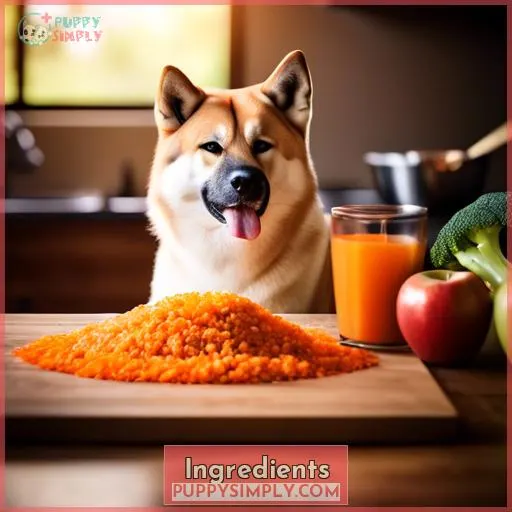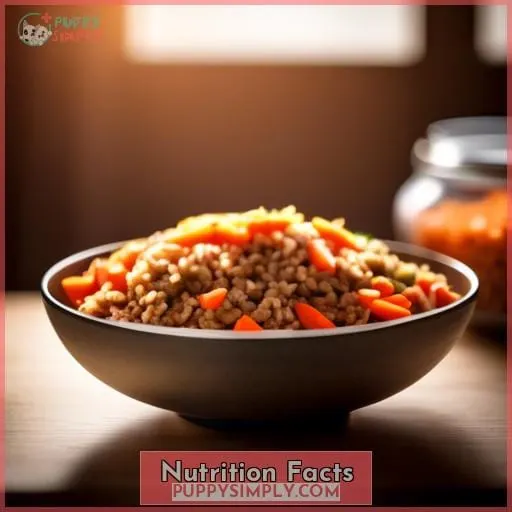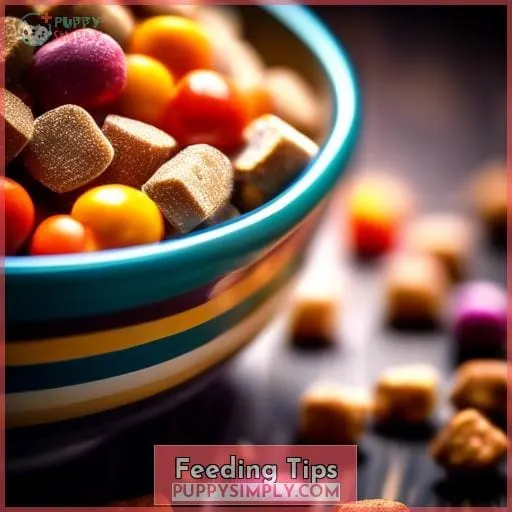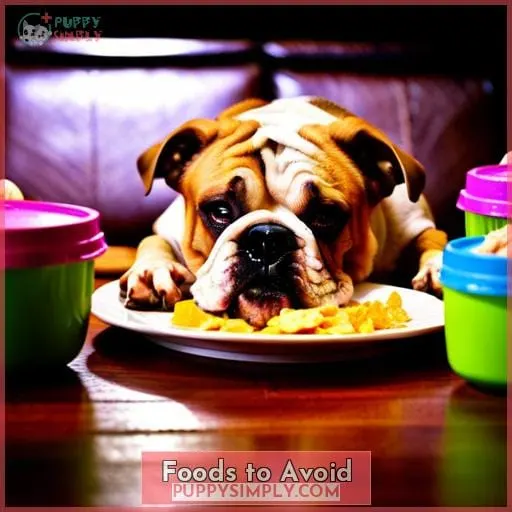This site is supported by our readers. We may earn a commission, at no cost to you, if you purchase through links.
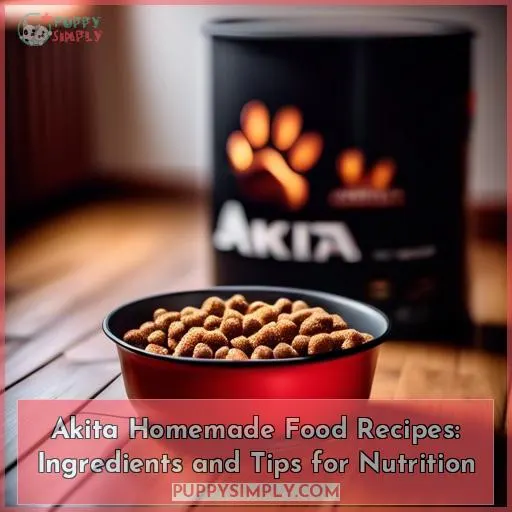 Your Akita’s nutrition is in your hands.
Your Akita’s nutrition is in your hands.
Add simple, nutritious ingredients with key nutrients to keep your dog healthy.
The right homemade recipes balance protein, carbs, fats, and micronutrients tailored for your dog’s breed and stage of life.
Monitor energy levels and focus as you transition food.
Read on to discover Akita homemade dog food recipes, serving sizes, and tips for optimal nutrition.
Table Of Contents
- Key Takeaways
- Ingredients
- Nutrition Facts
- Benefits
- Potential Risks
- Guidelines to Follow
- Best Recipes
- Feeding Tips
- Foods to Avoid
- Making the Switch
- Monitoring Health
- Frequently Asked Questions (FAQs)
- How much homemade food should I feed my Akita puppy vs my adult Akita?
- Can I mix kibble with homemade food for my Akita?
- What kitchen tools and cookware does an Akita owner need to prepare homemade meals?
- How do I know if a recipe contains the right nutrients for my Akita?
- What human foods or ingredients should never be fed to Akitas?
- Conclusion
Key Takeaways
- Lean protein sources like chicken, turkey, and beef should make up the bulk of homemade Akita dog food recipes.
- Incorporate nutrient-rich fruits, vegetables, healthy fats, and whole grains to provide balanced nutrition.
- Gradually transitioning to homemade food over 5-7 days can prevent digestive issues.
- Failing to meet an Akita’s nutritional needs with a homemade diet can negatively impact health.
Ingredients
- You’ll need quality proteins, whole grains, vegetables, fruits, healthy fats, vitamins, and minerals to create nutritious homemade meals for your Akita.
- Focus on lean meats like chicken, turkey, lean cuts of beef, or quality proteins like eggs.
- Choose whole grains like brown rice, barley, or quinoa and nutrient-dense veggies and fruits.
- Healthy fats like salmon, avocado, and olive oil provide Omega-3s.
- Incorporate supplements or rotate ingredients to ensure adequate vitamins and minerals.
- Adjust recipes seasonally, accommodating dietary restrictions.
- Vary proteins, fruits, and veggies for different flavors and textures.
- Emphasizing quality, whole ingredients tailored to your Akita’s needs builds health.
Nutrition Facts
Taking into account the ingredients, you’d want to know the precise nutrition facts per serving to ensure it meets your Akita’s needs – containing adequate protein, fat, carbs, and other key nutrients.
Analyzing the ingredients and understanding your Akita’s digestion is key before exploring supplements or comparing brands.
An Akita diet should have high protein and fat content to support their active lifestyle and muscular build.
Evaluate portion sizes based on your individual dog’s age, size, and activity level.
Homemade diets allow control over ingredients while commercial diets simplify preparation.
Focus on whole, unprocessed ingredients to maximize nutrition.
Consult your veterinarian if considering major dietary changes, as they impact health.
Benefits
When making your Akita’s food at home, you gain more control over their health.
Home cooking allows you to choose higher quality ingredients tailored to your dog’s needs.
This can lead to better nutrition and potentially prevent certain health issues that commercial kibble could cause over time.
Healthier Habits
Preparing homemade food allows your Akita to develop better dietary habits that support health:
- Improved meal planning tailored to your dog’s needs.
- Understanding canine nutrition requirements.
- Smoother dietary transitions with homemade treats.
Consulting a veterinarian ensures a balanced diet that promotes fiber intake, hydration, and overall Akita wellness.
Quality Control
Your ingredient selection ensures homemade meals meet your Akita’s nutritional needs.
When making homemade dog food for your Akita, be sure to follow recipes precisely.
Use clear instructions for cooking techniques, ingredients, and storage to provide balanced nutrition.
Consider substitutions or flavor variations occasionally, but don’t stray too far from proven Akita homemade dog food recipes.
Making the transition requires care to adjust amounts as needed.
Potential Risks
You’ll face some dangers if you don’t understand your Akita’s nutritional requirements when preparing homemade food.
- Not grasping the balanced nutritional needs specific to Akitas risks inadequate nutrients or unsafe proportions in their diet.
- Choosing recipes with unsafe or low-quality ingredients could negatively impact your Akita’s health over time.
- Failing to gradually transition your Akita onto a new homemade diet risks upsetting their digestive system or causing refusal to eat.
Guidelines to Follow
When making homemade food for your Akita, it’s critical to understand their protein needs.
Akitas require a high-protein diet, with sources coming from foods like chicken, beef, eggs, and fish.
You must also monitor the fat content in Akita diets to prevent obesity and related health issues.
Protein Needs
One nutrition guideline to follow for Akitas is ensuring they receive adequate protein in their diet, which builds and repairs their muscles and other body tissues.
Quality protein sources like chicken, beef, fish, and eggs should account for at least 18% of your Akita’s daily caloric intake.
When preparing homemade food, focus on lean meats cooked gently to preserve nutrients and supplement with healthy oils for a balanced nutrient profile.
Thoughtfully incorporating supplements can help optimize your Akita’s nutrition.
Fat Content
In formulating homemade meals for your Akita, you must account for providing quality fat sources responsible for:
- Supplying energy
- Facilitating growth and development
- Aiding in nutrient absorption
- Omega-3 fatty acids for skin and coat health
- Omega-6 fatty acids for immune system support
- Monounsaturated fats for heart health
- Appropriate calories to maintain ideal body condition
Best Recipes
When making homemade food for your Akita, focus on recipes with:
- Lean protein sources like chicken and rice
- Beef and vegetables
These recipes provide balanced nutrition from quality ingredients without unnecessary fillers.
Stick to simple whole food recipes to meet your Akita’s nutritional needs.
Chicken and Rice
From following the guidelines, whip up this delicious chicken and rice recipe using ingredients like chicken breasts, brown rice, carrots, and chicken broth.
Bake the chicken and rice casserole for 35-40 minutes until the chicken is fully cooked through.
Consider substitutions like turkey, quinoa, sweet potatoes, or vegetable broth for variation.
Akitas tend to love this simple homemade meal.
Beef and Veggies
When making the beef and veggie recipe, start by browning ground beef with onions and garlic.
Add carrots, broccoli, cauliflower, peas, and beef broth.
Use 93% lean ground beef.
Cook until beef is no longer pink.
Add low sodium beef broth.
Test temperature before serving.
Feeding Tips
Measure your Akita’s food daily to ensure proper portion control.
Use a measuring cup to portion out the recommended amount of food based on your dog’s age, size, and activity level.
Keeping your Akita at a healthy weight will support joint health and longevity.
Feed your Akita twice per day, once in the morning and once in the evening, to promote regular bathroom habits and steady energy.
Transition homemade diets slowly over 5-7 days, gradually adjusting ratios to allow healthy digestion.
Offer small homemade treats like bananas, blueberries, or sweet potatoes for positive reinforcement during training.
Foods to Avoid
The avoidance of harmful ingredients enables you to safeguard your Akita’s health.
As an Akita owner, you must be aware of foods that can be toxic or trigger allergies.
Onions, garlic, chocolate, grapes, raisins, macadamia nuts, xylitol, and foods high in salt or fat can all pose dietary dangers.
Carefully read ingredient labels to identify and avoid these forbidden substances, as they can lead to gastrointestinal, kidney, or even neurological issues.
Instead, craft homemade recipes using healthful whole foods like chicken, rice, carrots, sweet potatoes, eggs, yogurt, and omega-3 rich fish.
With allergen awareness and avoidance of toxic foods, you can nourish your Akita and protect them from harm.
Making the Switch
How do you gradually transition your Akita from commercial dog food to homemade food?
Start by mixing a small amount of the new homemade food into their regular kibble, gradually increasing the ratio over the course of two weeks.
This allows time for dietary adjustments and ensures balanced nutrient intake.
Introduce new proteins separately to monitor for allergies or intolerances.
Meal prep homemade recipes in advance during the transition so you have healthy, tailored meals ready to mix with kibble.
Be patient, attentive to changes in energy, appetite, and stool, and adjust the transition pace and homemade recipes as needed to ease your Akita into better health.
Following these tips will make switching to homemade food smooth for both you and your Akita.
Monitoring Health
After switching your Akita to a homemade diet, you’ll want to monitor their health.
Schedule regular veterinarian checkups.
As their nutritionist, track your Akita’s weight, body condition, and energy levels.
Consult your vet every 6 months to analyze the homemade meals’ nutrient balance and discuss any needed adjustments.
They can assess organ function through bloodwork.
An active Akita needs more calories than an idle house pet; adjust portions depending on their exercise routine.
Vet consultations, weight tracking, and checkups ensure your homemade recipes nourish your Akita completely, preventing deficiencies that lead to disease.
As the one preparing their food, you bear responsibility for monitoring their health.
Through partnership with your vet and care in preparation, your Akita can thrive on homemade meals.
Frequently Asked Questions (FAQs)
How much homemade food should I feed my Akita puppy vs my adult Akita?
Feed your Akita puppy three 1⁄2-cup meals per day of the homemade food until 4 months old.
Then, feed two 3⁄4-cup meals until fully grown around 18 months.
Adult Akitas get 2 cups split between morning and evening feedings.
Always monitor your dog’s body condition and adjust portions as needed.
Can I mix kibble with homemade food for my Akita?
Yes, you can mix kibble with homemade food for your Akita.
This helps transition to homemade while ensuring complete nutrition.
Slowly adjust ratios over two weeks, decreasing kibble while monitoring energy, stool, and coat health.
Consult your vet if concerns arise.
What kitchen tools and cookware does an Akita owner need to prepare homemade meals?
When preparing homemade meals for your Akita, essential kitchen tools include:
- A sharp chef’s knife for chopping
- A large pot for cooking
- Storage containers
- Measuring cups and spoons
- A food scale
- Blender or food processor
- An instant-read thermometer to ensure proper cooking temperatures
Thoughtfully prep ingredients in clean spaces for your pup’s health.
How do I know if a recipe contains the right nutrients for my Akita?
Consult with your veterinarian to analyze the nutrient profile.
They can advise if levels of protein, fat, carbs, vitamins, and minerals meet your Akita’s needs based on age, size, and activity level.
Adjust as needed.
What human foods or ingredients should never be fed to Akitas?
Never feed Akitas grapes, raisins, onions, garlic, chocolate, or foods containing xylitol, as these can be toxic.
Focus instead on quality proteins, healthy fats, vitamins, and minerals from whole food sources suited to their breed-specific needs.
Consult your vet if ever unsure.
Conclusion
Ultimately, with the right ingredients and recipes, you can take control of your Akita’s health.
Monitor reactions as you transition food, but homemade meals with lean proteins, fiber-rich carbs and veggies, healthy fats, and key micronutrients tailored to your dog’s needs can nurture them from the inside out.
Though it takes effort, homemade Akita dog food empowers you to provide quality nutrition full of love.

